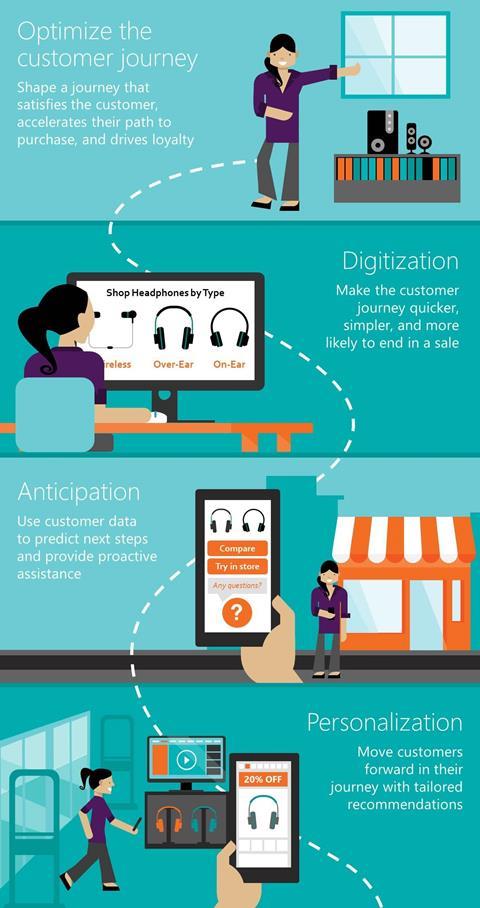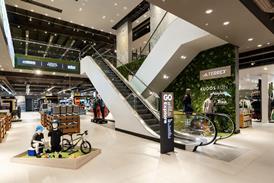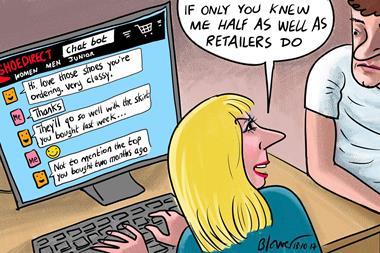Personalisation is a strategic focus for many retailers, yet customers are not feeling the love. Microsoft examines where this disconnect is coming from.
The vast majority of retailers have identified personalisation as a powerful weapon in the battle to secure sales and customer loyalty.
“96% of retailers believe a tailored shopping experience can influence a sale”
However, shoppers themselves are demanding a more personalised service than they currently receive.
Research from IT consultancy Infosys suggests 96% of retailers believe a tailored shopping experience can influence a sale. And almost the same percentage consider it a strategic focus for their business in today’s competitive market.
However, one third of customers are calling for greater personalisation, so what is causing the disconnect between retailers’ planning and execution?

Drowning in data, lacking in insight
Firstly, retailers are data-rich but often lacking in insight.
They hold various pieces of information but don’t necessarily combine them for a bigger picture of who their customers are and what they will buy.
Many retailers can send an email to one of their customers recommending a product related to the last one they purchased online.
“Consumer data is the new oil. Mine it efficiently and responsibly because there are significant riches to be had”
But can they tie it in with an item that was bought in store? Can they distinguish an item that was bought for personal use from one that was purchased as a gift? What about other influencing factors in the shopping process?
Retailers should now be able to understand what their regular shoppers buy, as well as their fulfilment preferences.
However, when trying to personalise an offer online, wider variables such as weather or social media sentiment can be considered to secure a sale.
Consumer data is the new oil in terms of its commercial value. Mine it efficiently and responsibly from various sources, and then let it fuel your business decisions because there are significant riches to be had.
Personalisation is an ongoing process
No one said personalisation was easy.
Only 12% of retail executives surveyed by Microsoft acknowledge their companies are extremely effective at using analytics to personalise promotions for specific customers.
This is partly because the goalposts are always being moved. People change and so do their shopping habits and needs.
“Only 12% of retail executives surveyed by Microsoft say their companies are extremely effective at using analytics to personalise promotions”
If one marketing campaign based on a personalised email was a success, it doesn’t mean that the next one will be.
Test and learn is the new retail mantra, and it’s a valid approach when executing personalisation strategies.
By continually trying new tactics and assessing technology investments within a wider personalisation agenda, retailers can keep pace with customers’ demands and make marketing count.
Keep shoppers coming back

Retailers should be aiming to tailor in-store experiences and impress with outstanding service that will keep shoppers coming back time and time again.
To assist in this quest, Microsoft is helping companies process a vast amount of customer data to generate effective personalised experiences and bridge the gap between digital and physical.
Retailers and consumers alike want more personalisation in the shopping experience because it has multiple benefits for both sides.
The technology and know-how is in place; it just requires smart thinking and comprehensive data analysis to allow retailers to realise personalisation’s powerful potential.
Optimise the customer journey
Imagine you are planning to buy a pair of shoes, or try a new restaurant.
You might do some research online, compare prices among competitors, consult reviews or engage your social network for references.
You’ll probably add new brands to the list of contenders before narrowing it down and finally making a purchase.
Thanks to online and mobile channels, the customer journey is now increasingly complex.
“Using research about customer behaviour patterns, companies are trying to understand the winding roads customers take”
From a retailer’s point of view, it can be a long, unstructured process, with no guarantee of a purchase at the end.
That’s where customer journey mapping comes in.
Using research about customer behaviour patterns, companies are trying to understand the winding roads customers may take between consideration and purchase.
Once retailers understand the touchpoints in that progression, they can strategise to shape the journey that satisfies the customer, accelerates their path to purchase and drives loyalty.
To stay at the leading edge, retailers need to actively guide their customers through a journey that is mutually beneficial for both parties.
To find out more about how Microsoft can support you with personalised experiences, click here.

































No comments yet